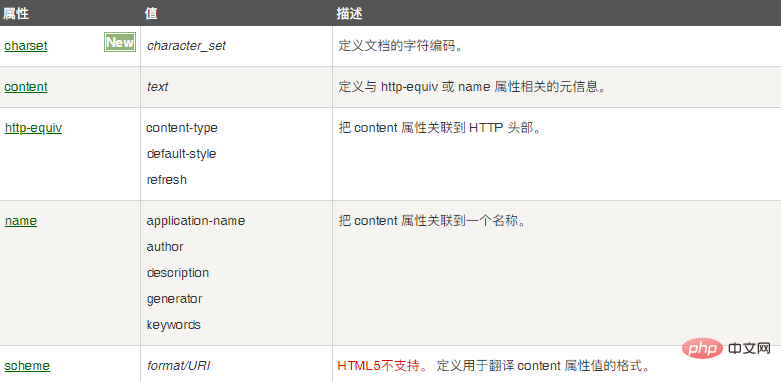What does meta mean in html?
In HTML, meta means an auxiliary tag in the head area. This tag is used to provide the original data information of the corresponding page; this tag is a single tag and does not contain any content. The attribute definition of the tag Name or value pairs associated with the document, such as description and keywords for search engines and update frequency.

The operating environment of this tutorial: Windows 10 system, HTML5 version, Dell G3 computer.
What does meta mean in html
meta is an auxiliary tag in the head area of html language. It is located at the head of the document and does not contain any content. A tag's properties define the name/value pairs associated with the document.
The meta element can provide meta-information (meta-information) of related pages, such as descriptions and keywords for search engines and update frequency.
Metadata is the data information of the data. The
tag provides metadata for an HTML document. The metadata will not be displayed on the client, but will be parsed by the browser.
The META element is usually used to specify the description, keywords, last modification time of the file, author and other metadata of the web page.
Metadata can be called using browsers (how content is displayed or pages are reloaded), search engines (keywords), or other web services.
Examples are as follows:
Example 1 - Define document keywords for search engines:
<meta name="keywords" content="HTML, CSS, XML, XHTML, JavaScript">
Example 2 - Define web pages Description:
<meta name="description" content="Free Web tutorials on HTML and CSS">
Example 3 - Definition page author:
<meta name="author" content="Hege Refsnes">
Example 4 - Refresh the page every 30 seconds:
<meta http-equiv="refresh" content="30">
The attributes supported by the tag are as follows:

(Learning video sharing: css video tutorial, html video tutorial)
The above is the detailed content of What does meta mean in html?. For more information, please follow other related articles on the PHP Chinese website!

Hot AI Tools

Undresser.AI Undress
AI-powered app for creating realistic nude photos

AI Clothes Remover
Online AI tool for removing clothes from photos.

Undress AI Tool
Undress images for free

Clothoff.io
AI clothes remover

AI Hentai Generator
Generate AI Hentai for free.

Hot Article

Hot Tools

Notepad++7.3.1
Easy-to-use and free code editor

SublimeText3 Chinese version
Chinese version, very easy to use

Zend Studio 13.0.1
Powerful PHP integrated development environment

Dreamweaver CS6
Visual web development tools

SublimeText3 Mac version
God-level code editing software (SublimeText3)

Hot Topics
 1386
1386
 52
52
 Table Border in HTML
Sep 04, 2024 pm 04:49 PM
Table Border in HTML
Sep 04, 2024 pm 04:49 PM
Guide to Table Border in HTML. Here we discuss multiple ways for defining table-border with examples of the Table Border in HTML.
 HTML margin-left
Sep 04, 2024 pm 04:48 PM
HTML margin-left
Sep 04, 2024 pm 04:48 PM
Guide to HTML margin-left. Here we discuss a brief overview on HTML margin-left and its Examples along with its Code Implementation.
 Nested Table in HTML
Sep 04, 2024 pm 04:49 PM
Nested Table in HTML
Sep 04, 2024 pm 04:49 PM
This is a guide to Nested Table in HTML. Here we discuss how to create a table within the table along with the respective examples.
 HTML Table Layout
Sep 04, 2024 pm 04:54 PM
HTML Table Layout
Sep 04, 2024 pm 04:54 PM
Guide to HTML Table Layout. Here we discuss the Values of HTML Table Layout along with the examples and outputs n detail.
 HTML Input Placeholder
Sep 04, 2024 pm 04:54 PM
HTML Input Placeholder
Sep 04, 2024 pm 04:54 PM
Guide to HTML Input Placeholder. Here we discuss the Examples of HTML Input Placeholder along with the codes and outputs.
 HTML Ordered List
Sep 04, 2024 pm 04:43 PM
HTML Ordered List
Sep 04, 2024 pm 04:43 PM
Guide to the HTML Ordered List. Here we also discuss introduction of HTML Ordered list and types along with their example respectively
 Moving Text in HTML
Sep 04, 2024 pm 04:45 PM
Moving Text in HTML
Sep 04, 2024 pm 04:45 PM
Guide to Moving Text in HTML. Here we discuss an introduction, how marquee tag work with syntax and examples to implement.
 HTML onclick Button
Sep 04, 2024 pm 04:49 PM
HTML onclick Button
Sep 04, 2024 pm 04:49 PM
Guide to HTML onclick Button. Here we discuss their introduction, working, examples and onclick Event in various events respectively.




